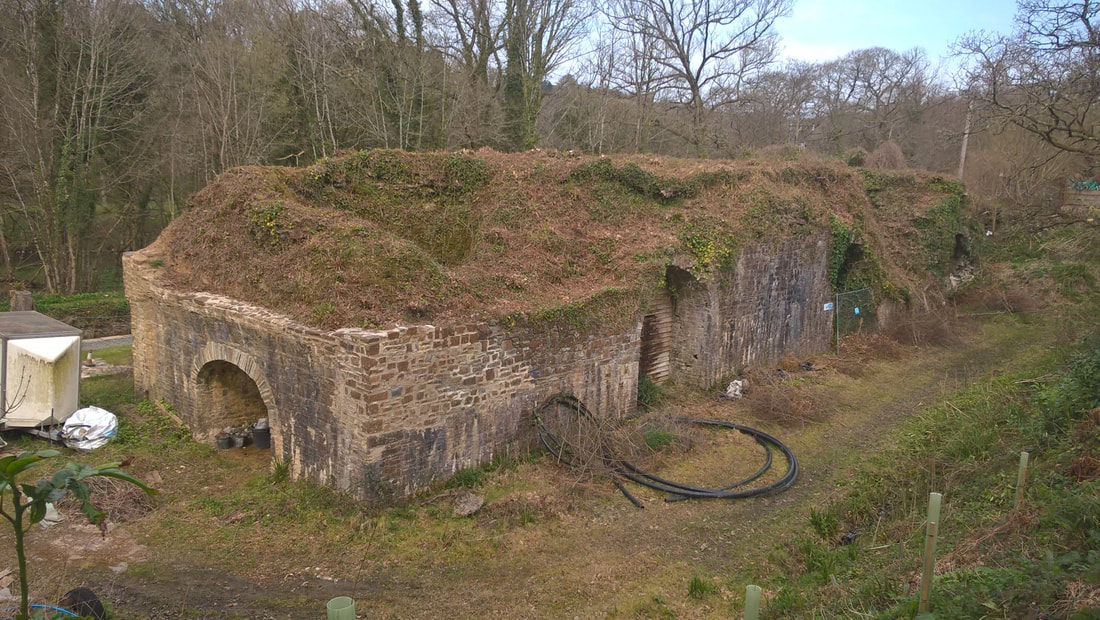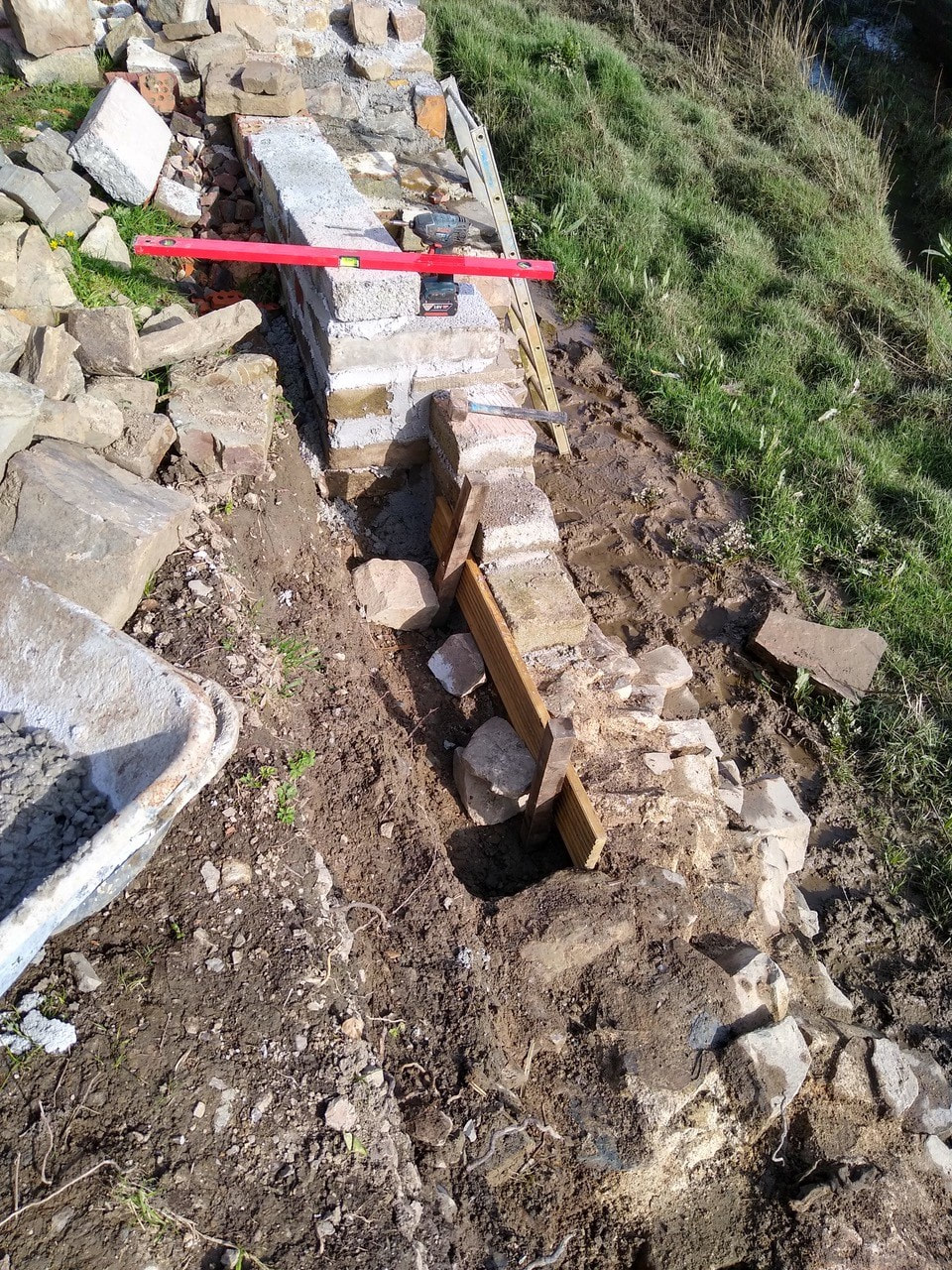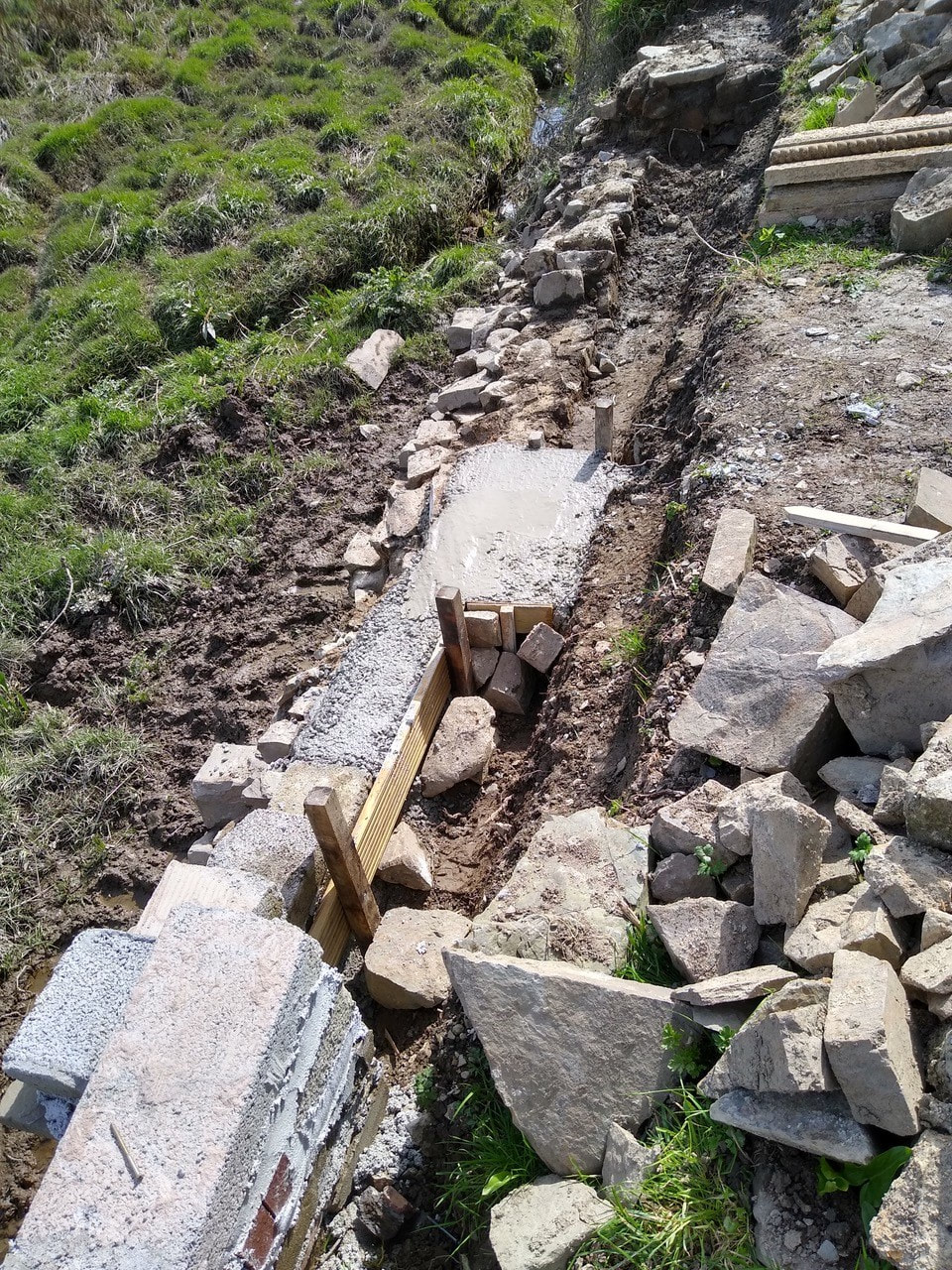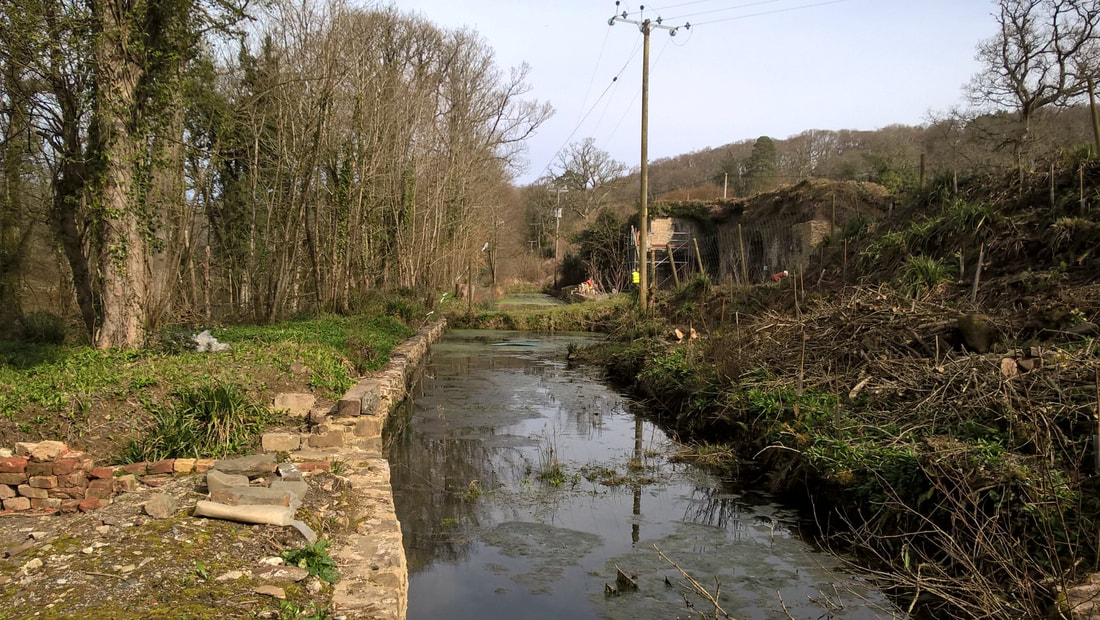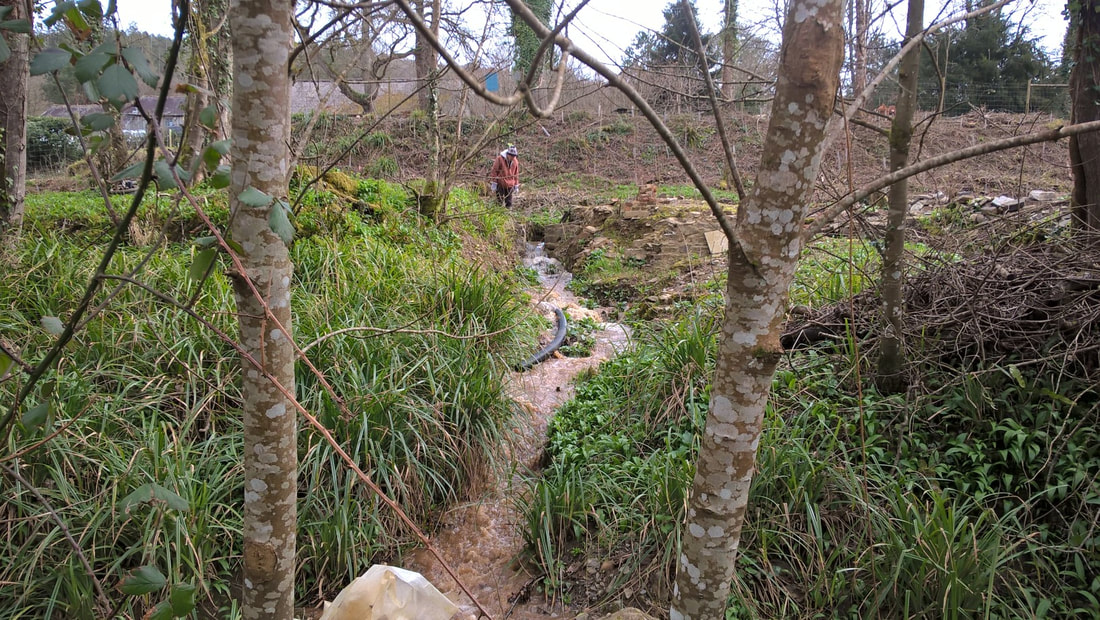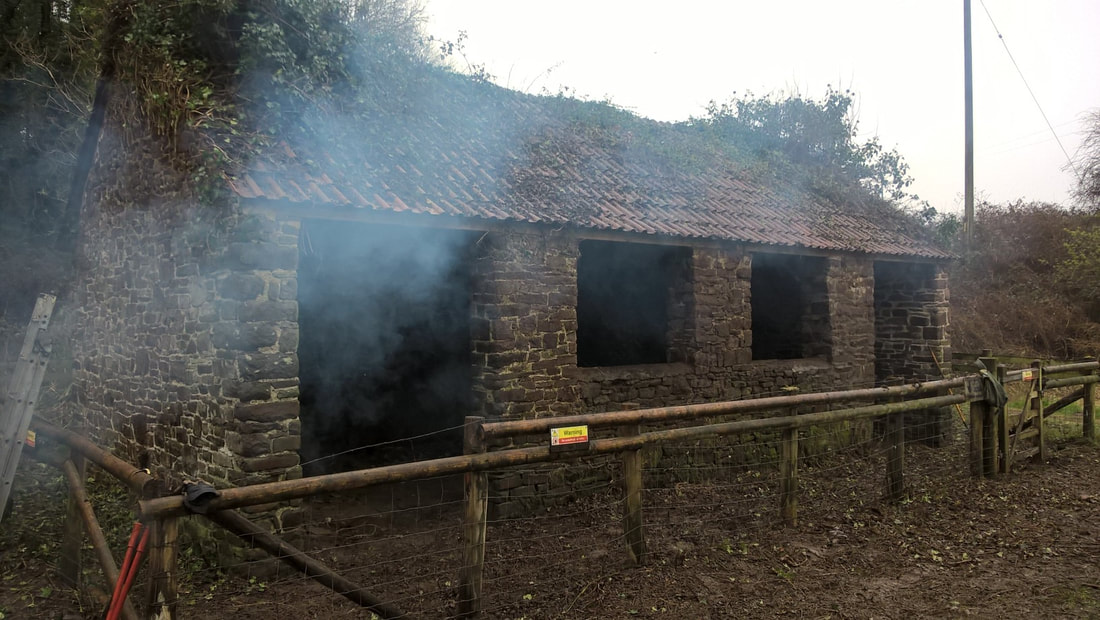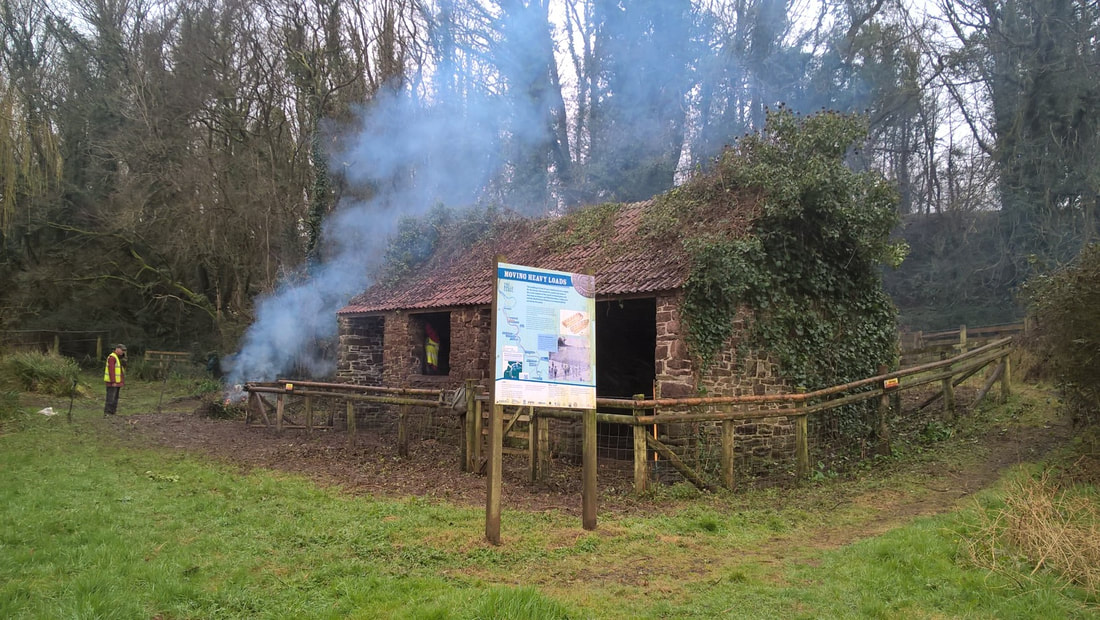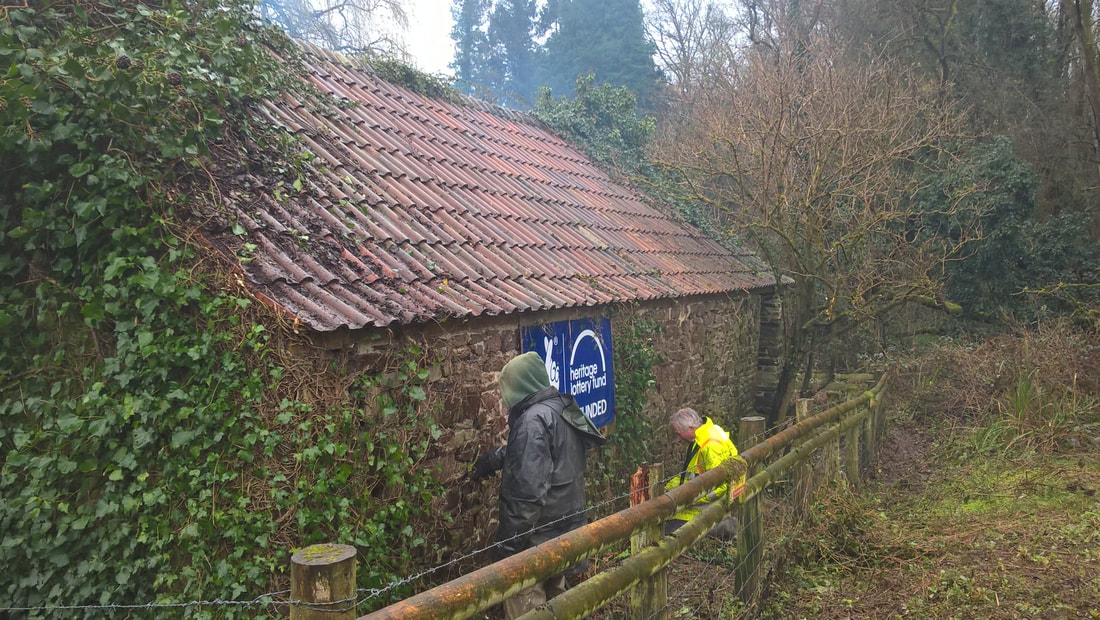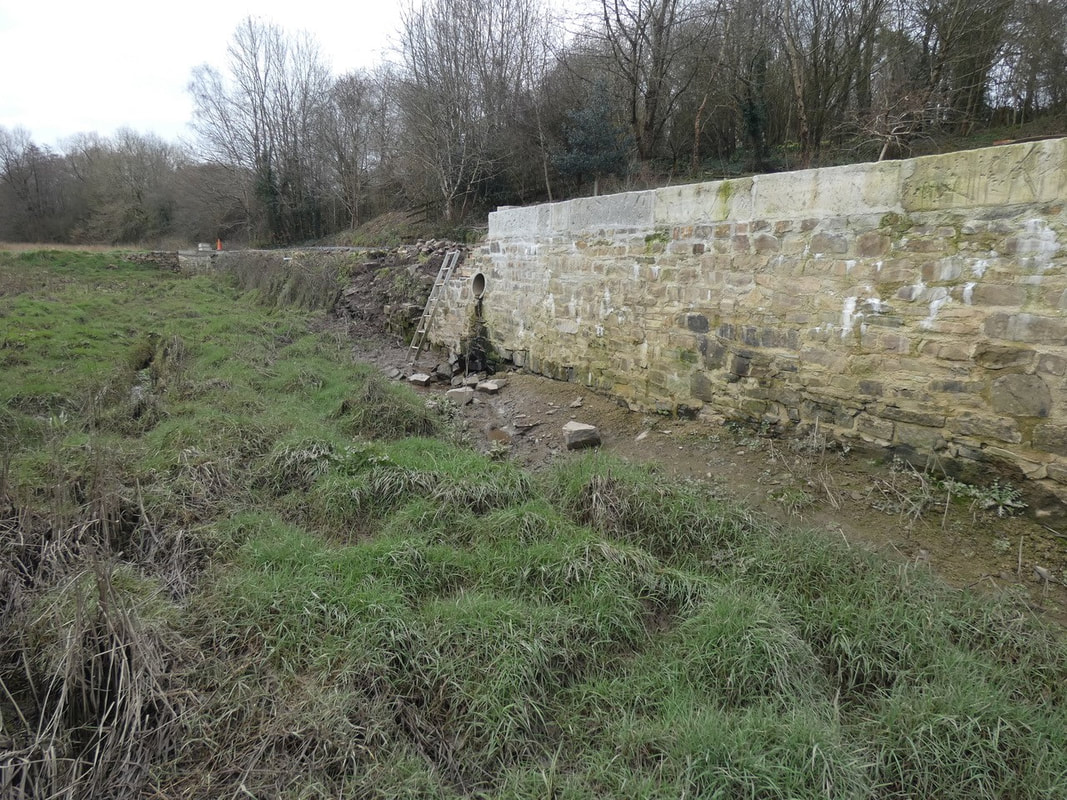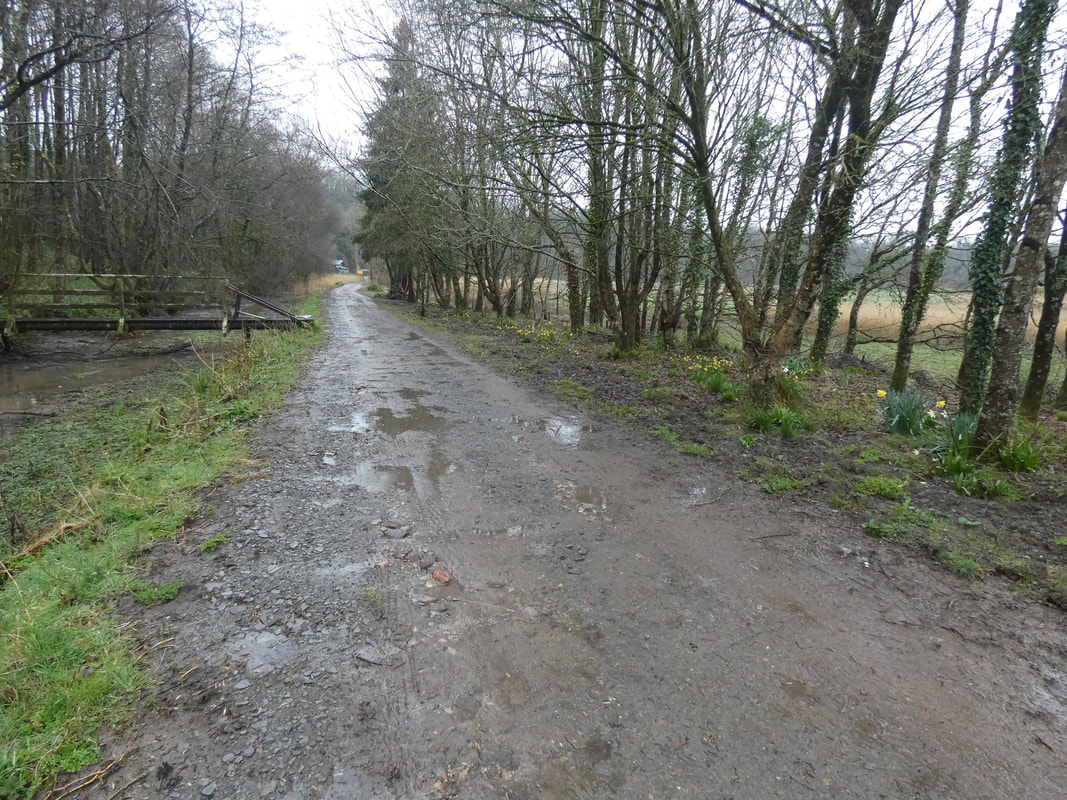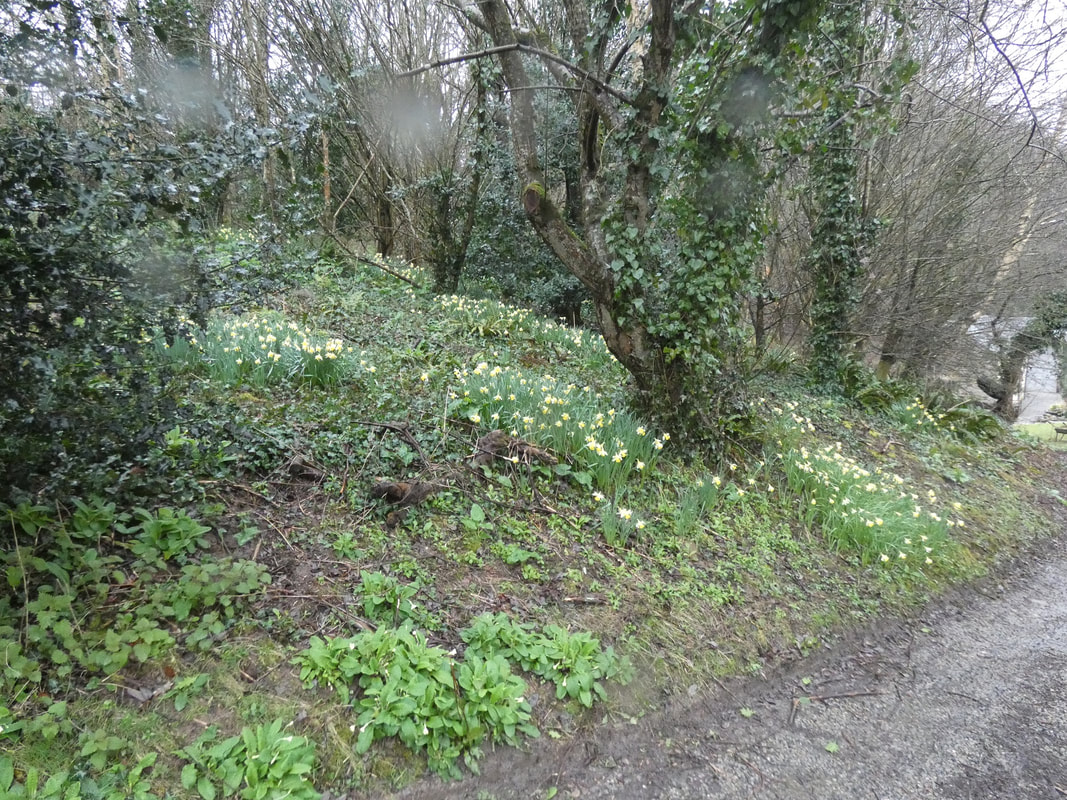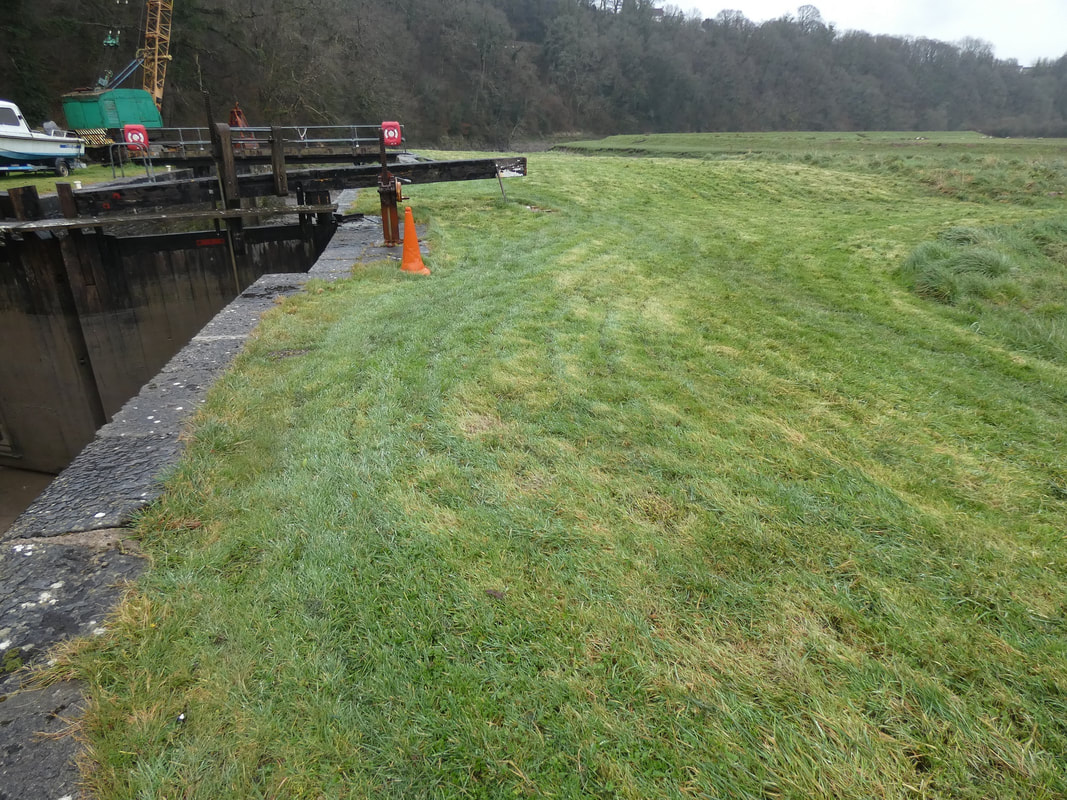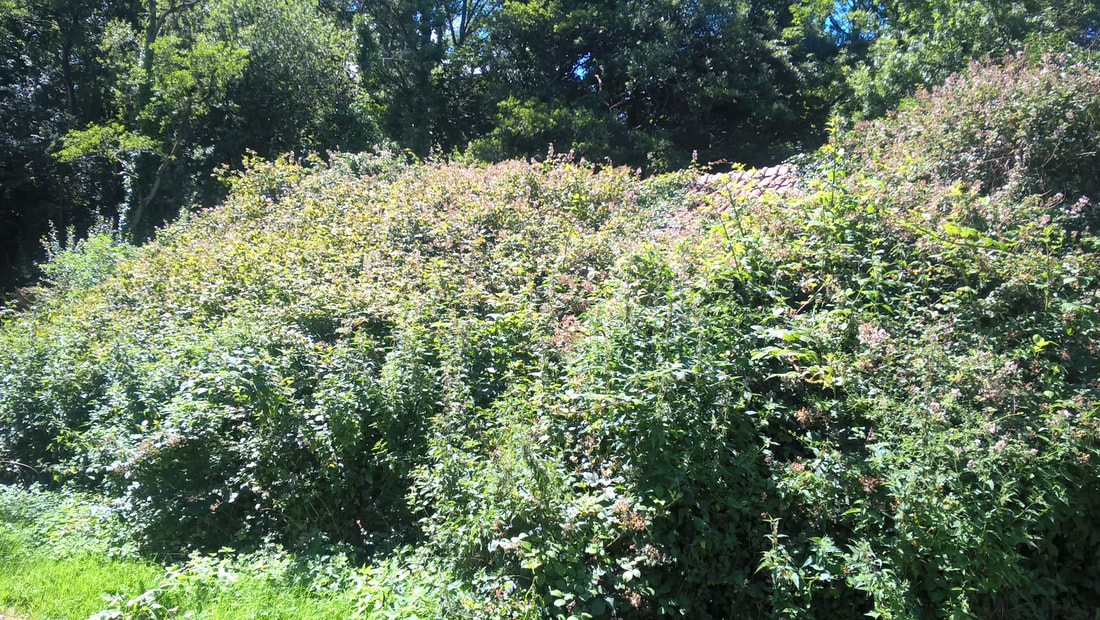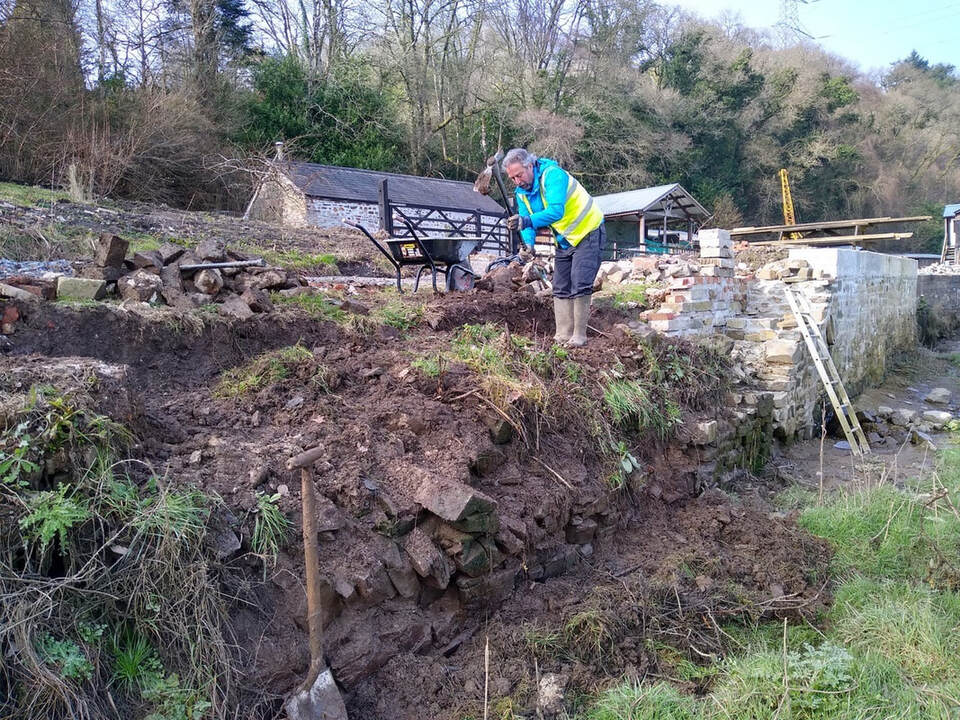March News
ROSEMOOR RESTORATION REPORT by Tony Nicholls - 31st March 2021
Having completed our mini-project at Ridd, the team returned to the Rosemoor site this week and were greeted by the pleasing sight of RHS Rosemoor staff cutting out the giant tree stump in the middle of the tucking mill – something which had proved beyond our limited resources. It was good to see the beast finally vanquished! The limekiln itself has been given its annual 'haircut' which is always a significant moment as it reveals the openings of the pots. Sadly, it also reveals how badly degraded the top of the structure has become over the years.
Having completed our mini-project at Ridd, the team returned to the Rosemoor site this week and were greeted by the pleasing sight of RHS Rosemoor staff cutting out the giant tree stump in the middle of the tucking mill – something which had proved beyond our limited resources. It was good to see the beast finally vanquished! The limekiln itself has been given its annual 'haircut' which is always a significant moment as it reveals the openings of the pots. Sadly, it also reveals how badly degraded the top of the structure has become over the years.
Lime kiln with vegetation removed
While we wait for the contractors to raise and extend the scaffolding to enable us to repair the topmost layers of stonework on the lime kiln, we decided to turn our attention once more to the tucking mill. We were amazed to see how far the ramsons, or wild garlic, had spread – a real sea of plants have quickly established themselves in the area of the tucking mill and beyond. We made a start on re-setting the flagstones in the second flight of steps and re-pointing the brickwork. Our intention is to use the excavated stone to re-build the foundations of the walls to give a good indication of the layout of the original building.
Wild garlic
With the upper basin partially drained, we were also able to start exposing the stonework on the eastern wall opposite the tucking mill. This needs to be repaired but the upper courses of stone have been pushed badly out of line by the weight of earth on the bank above. To make a solid repair, we will have to remove at least the top two courses of stone to get down to a sound base. Inevitably, there is another big tree stump which has grown in the middle of the wall and demolished much of it. Ideally, this also needs to be removed to enable a proper repair. If proof is needed of Parkinson's Law, it is here - the more progress we make, the more there seems to do!
Rebuilding wall of the Tucking Mill
Repointed steps
Exposed stonework of basin
Generally, working parties are held every Wednesday morning, meeting in the main car park at RHS Rosemoor, Torrington at 9.30am. (NB. Arrangements may vary during Covid restrictions). Please contact Project Manager, Ian Harrison (tel.01237- 475707) for more information.
SEA LOCK REPORT by Michael Elliott - 30th March 2021
With one of the small team only working half a shift, and limited supplies, it was decided make concrete. This helped eke out the supplies, and provided a foundation for rebuilding the next section of the wharf wall. The concrete was duly placed along the original alignment of the back of the wall and the first of its buttresses. Although progress was limited, it was a lovely spring morning and a joy to be out doing something for posterity.
With one of the small team only working half a shift, and limited supplies, it was decided make concrete. This helped eke out the supplies, and provided a foundation for rebuilding the next section of the wharf wall. The concrete was duly placed along the original alignment of the back of the wall and the first of its buttresses. Although progress was limited, it was a lovely spring morning and a joy to be out doing something for posterity.
FURZEBEAM REPORT by Michael Elliott - 24th March 2021
This week the Wednesday group split into two working parties, with one group finishing off at Ridd, and the other back at Furzebeam to tackle the muddy towpath diversion, again!. Additional drainage channels were dug in an effort to channel the water seeping out of the hillside. The heap of scalpings (muddy gravel) near the roving bridge was raked to try and reduce reduce its soil content, and the stony product wheelbarrowed to top off the path. Attention then turned to digging brambles, ferns, rushes, tree stumps and a holly bush out of an adjacent section of the canal bed.
This week the Wednesday group split into two working parties, with one group finishing off at Ridd, and the other back at Furzebeam to tackle the muddy towpath diversion, again!. Additional drainage channels were dug in an effort to channel the water seeping out of the hillside. The heap of scalpings (muddy gravel) near the roving bridge was raked to try and reduce reduce its soil content, and the stony product wheelbarrowed to top off the path. Attention then turned to digging brambles, ferns, rushes, tree stumps and a holly bush out of an adjacent section of the canal bed.
SEA LOCK RESTORATION - Report by Michael Elliott - 23rd March 2021
The small team at Sea Lock were able to turn their attention to the rebuilding of the wharf wall for the first time this year. Consequently we split our efforts into mixing mortar, removing soil and loose rock from the next section of the wall, and rebuilding the back of the wall along the top of the exposed original. Fifteen wheelbarrow loads of mud and a large pile of rock later, a small part of the facing of the wall had also been rebuilt.
The small team at Sea Lock were able to turn their attention to the rebuilding of the wharf wall for the first time this year. Consequently we split our efforts into mixing mortar, removing soil and loose rock from the next section of the wall, and rebuilding the back of the wall along the top of the exposed original. Fifteen wheelbarrow loads of mud and a large pile of rock later, a small part of the facing of the wall had also been rebuilt.
ROSEMOOR REPORT by Tony Nicholls - 17th March 2021
In a change of plan, the team met at RHS Rosemoor this week. It was good to be back on site after an absence of some four months and to see it looking in reasonably good shape. The purpose of our visit was to investigate areas of leakage between the canal basin and Darkham Weir. These are of concern as the potential water loss over a year can be significant. It is also important in the context of RHS Rosemoor's plans as they hope to use the canal as a self-sustaining source of water for their estate in the future. It is therefore vital to identify and repair any leaks.
In a change of plan, the team met at RHS Rosemoor this week. It was good to be back on site after an absence of some four months and to see it looking in reasonably good shape. The purpose of our visit was to investigate areas of leakage between the canal basin and Darkham Weir. These are of concern as the potential water loss over a year can be significant. It is also important in the context of RHS Rosemoor's plans as they hope to use the canal as a self-sustaining source of water for their estate in the future. It is therefore vital to identify and repair any leaks.
The towpath looking towards Darkham Weir
Following the towpath south from the tucking mill, we located two points of possible leakage. To prove that the water was actually flowing out of the canal a bright green, environmentally friendly dye was poured into the canal (with surreal effects!) while we waited to see if it appeared in the outflow. In both instances a tell-tale green tinge soon appeared and the location of the leaks marked for future reference. Our intention is to drain the canal to let the bed dry out over the summer and then, in conjunction with RHS Rosemoor, to repair the damaged areas and make the canal watertight again.
Dyed water emerging from leak
View of the canal basin from the tucking mill
Finally, both the upper and lower sluices were opened to start the drainage process.
Generally, working parties are held every Wednesday morning, meeting in the main car park at RHS Rosemoor, Torrington at 9.30am. (NB. Arrangements may vary during Covid restrictions). Please contact Project Manager, Ian Harrison (tel.01237- 475707) for more information.
MORE WALL DESTRUCTION AT SEA LOCK by Adrian Wills - 16th March 2021
The weather was cool and slightly damp which made for good conditions to continue wall renovating. Whilst Michael Elliott worked on top of the wall clearing it of soil and loose stones, I worked down in the wharf, wallowing in the glutinous mud. Initially appearing to make little progress we finally had another couple of metres of clean, sound masonry ready to be rebuilt.
The weather was cool and slightly damp which made for good conditions to continue wall renovating. Whilst Michael Elliott worked on top of the wall clearing it of soil and loose stones, I worked down in the wharf, wallowing in the glutinous mud. Initially appearing to make little progress we finally had another couple of metres of clean, sound masonry ready to be rebuilt.
As Michael was clearing a small trench along the back of the wall he came to a place where it suddenly became considerably wider and then, just under a metre further along, returned to its previous width. Continuing on this line the wall did the same thing again further along and we concluded these were probably buttresses built in at intervals.
Progressing no further than the second buttress for the day, we have reached a point where the wall is in a very poor state. When examining what stonework was exposed here once I had removed a hanging garden and tangle of brambles, I realised that this was a second place where the wall had been breached in the past in order for national grid power lines to be installed underneath. The wall here and at the other section where I knew a power cable to be situated, it has been rebuilt very shoddily and with little reference to the original build style.
Much of these two sections will require taking down a long way before they can be rebuilt in the appropriate manner.
VOLUNTEERS AT RIDD - Report by Tony Nicholls - 10th March 2021
Our working party convened at Ridd again this week to continue the clearance of the stables. Thankfully, we were able to work in reasonably dry conditions, the forecast storm arriving later in the afternoon.
Our working party convened at Ridd again this week to continue the clearance of the stables. Thankfully, we were able to work in reasonably dry conditions, the forecast storm arriving later in the afternoon.
|
By the end of the morning, we had successfully removed the last of the higher brambles from the eaves and the roof. There are two clumps of vegetation remaining at either gable end which are unfortunately too high for us to reach safely. However, most of the roof is now clear and virtually all the ivy which covered the walls has been stripped off resulting in a huge improvement in appearance. |
|
Over recent weeks we have also spent some time cutting back the vegetation at the base of the inclined plane. For the moment, we have left intact a bed of sedges in the centre to indicate the position of what we believe was the original stone pier separating the 'up' and 'down' channels of the plane. The base of the inclined plane can be seen just behind the metal gate rising to the point where it abuts the access road to Ridd Cottage. Further exploration is needed here and this may be part of a future project. |
Next week the team will split with two members finishing off the final tidying up at the stables and the rest going to Beam to continue our remedial work on this section of the canal.
Generally, working parties are held every Wednesday morning, meeting in the main car park at RHS Rosemoor, Torrington at 9.30am. (NB. Arrangements may vary during Covid restrictions). Please contact Project Manager, Ian Harrison (tel.01237- 475707) for more information.
SEA LOCK RESTORATION - Report by Michael Elliott - 9th March 2021
Dry weather again allowed work at Sea Lock to focus on the wharf wall. There is a long way to go to reach the canal crossing! The team focused on the section of wall from the week before. Over the 150 years or so since the canal closed, the lime mortar has turned to soil, and the pressure from the bank has shifted all but the lowest courses of stone. Another twenty wheelbarrow-loads of soil were removed from the top. A lot of loose rock was also removed from the face of the wall in an attempt to reach a firm base for rebuilding. There is still more soil and loose rock to remove before rebuilding this section can start.
Dry weather again allowed work at Sea Lock to focus on the wharf wall. There is a long way to go to reach the canal crossing! The team focused on the section of wall from the week before. Over the 150 years or so since the canal closed, the lime mortar has turned to soil, and the pressure from the bank has shifted all but the lowest courses of stone. Another twenty wheelbarrow-loads of soil were removed from the top. A lot of loose rock was also removed from the face of the wall in an attempt to reach a firm base for rebuilding. There is still more soil and loose rock to remove before rebuilding this section can start.
DAFFODILS & BLUEBELLS AT SEA LOCK by Adrian Wills - 10th March 2021
For many years it has been part of my regular daily routine to walk first thing in the morning, with mug of tea in hand, from my house down along the towpath to the site of Sea Lock. This is a throw-back to the time when my wife and I owned a Standard Poodle. When he was still quite young a friend remarked about him that he wasn’t a puppy, he was really a small pony which gives you some idea of how big he was.
Anyway, it gives me great pleasure to observe the changes of nature across the seasons and I was pleased of late to watch the daffodils push through the soil and stand tall and proud. Over the years as well as a considerable number of trees, I have planted many daffodil bulbs of varying types along the sides of the tow path and under those trees.
Most recently I have concentrated on planting the smaller variety of daffs’ (Pseudo Narcissus) since they are very similar to the wild daffodil. The taller varieties, whilst very attractive, are subject to battering by strong winds. This year however it has been the very sharp frosts which have knocked down many of the tall flowers. Unfortunately once the trumpet touches the ground slugs are rapidly attracted and quickly make a meal of them.
For many years it has been part of my regular daily routine to walk first thing in the morning, with mug of tea in hand, from my house down along the towpath to the site of Sea Lock. This is a throw-back to the time when my wife and I owned a Standard Poodle. When he was still quite young a friend remarked about him that he wasn’t a puppy, he was really a small pony which gives you some idea of how big he was.
Anyway, it gives me great pleasure to observe the changes of nature across the seasons and I was pleased of late to watch the daffodils push through the soil and stand tall and proud. Over the years as well as a considerable number of trees, I have planted many daffodil bulbs of varying types along the sides of the tow path and under those trees.
Most recently I have concentrated on planting the smaller variety of daffs’ (Pseudo Narcissus) since they are very similar to the wild daffodil. The taller varieties, whilst very attractive, are subject to battering by strong winds. This year however it has been the very sharp frosts which have knocked down many of the tall flowers. Unfortunately once the trumpet touches the ground slugs are rapidly attracted and quickly make a meal of them.
Apart from Daffodils I have planted Bluebell bulbs. Seeing swathes of blue through woodland is always a lovely sight. What I didn’t realise however, was that these Bluebells are of the Spanish variety not the native British ones. Whilst they spread easily they are now being considered as an invasive pest and need to be controlled. Just another little problem!
Yesterday, whilst Michael and Tony worked hard on clearing overburden on part of the wharf wall, preparing it for rebuilding, I concentrated on sorting out some pipes to help drain water from accumulating behind the wharf wall into the canal.
Yesterday, whilst Michael and Tony worked hard on clearing overburden on part of the wharf wall, preparing it for rebuilding, I concentrated on sorting out some pipes to help drain water from accumulating behind the wharf wall into the canal.
Later in the day, whilst the weather was still good I finished what I had started the day before – giving of the grass around the lock chamber its first cut of the year. Just as well I did because today started warmer than the previous few but has reverted to being wet and everything is once again soggy and slippery!
VOLUNTEERS AT RIDD - Report by Tony Nicholls - 3rd March 2021
For the last month – while we have not been able to work at RHS Rosemoor – a small group of volunteers has been carrying out some much-needed clearance at the bottom of the inclined plane at Ridd. We have not been able to devote as much attention to this area as we would like and it has become badly overgrown in places. The old stables (restored as part of a Lottery-funded project) have virtually disappeared under a thick blanket of brambles and ivy which is threatening to damage the fabric of the building.
For the last month – while we have not been able to work at RHS Rosemoor – a small group of volunteers has been carrying out some much-needed clearance at the bottom of the inclined plane at Ridd. We have not been able to devote as much attention to this area as we would like and it has become badly overgrown in places. The old stables (restored as part of a Lottery-funded project) have virtually disappeared under a thick blanket of brambles and ivy which is threatening to damage the fabric of the building.
In the first session we concentrated on gathering and burning the brash left by contractors after an earlier clearance of the site. We did this on a very cold, frosty morning so the bonfire was most welcome! We have also cut back much of the vegetation around the area of the old docking bays and dug up a swathe of sedges which had become well established here. We then started on the challenging task of removing the overgrowth around the stables. The 'before and after' photos show the extent of the work involved. However, we have made good progress during the last two weeks and the stables are once more visible again. A final working party is planned for next week when we hope to remove the remaining brambles and ivy from the roof.
Generally, working parties are held every Wednesday morning, meeting in the main car park at RHS Rosemoor, Torrington at 9.30am. (NB. Arrangements may vary during Covid restrictions). Please contact Project Manager, Ian Harrison (tel.01237- 475707) for more information.
SEA LOCK RESTORATION - Report by Michael Elliott - 2nd March 2021
With better weather and dryer ground, work at Sea Lock moved outside. We turned once again to the wharf wall. Work duly started with stripping the soil off the top of the next few metres. Thirty wheelbarrows of soil later, and we were only down about one foot (30cm), so there is a long way to go. The stones in the wall are all loose, so we will need to dismantle the wall to the bottom before rebuilding can start.
With better weather and dryer ground, work at Sea Lock moved outside. We turned once again to the wharf wall. Work duly started with stripping the soil off the top of the next few metres. Thirty wheelbarrows of soil later, and we were only down about one foot (30cm), so there is a long way to go. The stones in the wall are all loose, so we will need to dismantle the wall to the bottom before rebuilding can start.

